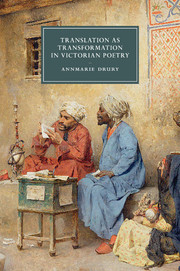Book contents
- Translation as Transformation in Victorian Poetry
- Cambridge Studies in Nineteenth-Century Literature and Culture
- Translation as Transformation in Victorian Poetry
- Copyright page
- Contents
- Figures
- Book part
- Introduction
- Chapter 1 Discovering a Victorian culture of translation
- Chapter 2 Idylls of the King, theMabinogion, and Tennyson’s faithless melancholy
- Chapter 3 In poetry and translation, Browning’s case for innovation
- Chapter 4 TheRubáiyátand its compass
- Chapter 5 The persistence of Victorian translation practice
- Epilogue
- Notes
- Bibliography
- Index
- Cambridge Studies in Nineteenth-Century Literature and Culture
- References
Bibliography
Published online by Cambridge University Press: 05 May 2015
- Translation as Transformation in Victorian Poetry
- Cambridge Studies in Nineteenth-Century Literature and Culture
- Translation as Transformation in Victorian Poetry
- Copyright page
- Contents
- Figures
- Book part
- Introduction
- Chapter 1 Discovering a Victorian culture of translation
- Chapter 2 Idylls of the King, theMabinogion, and Tennyson’s faithless melancholy
- Chapter 3 In poetry and translation, Browning’s case for innovation
- Chapter 4 TheRubáiyátand its compass
- Chapter 5 The persistence of Victorian translation practice
- Epilogue
- Notes
- Bibliography
- Index
- Cambridge Studies in Nineteenth-Century Literature and Culture
- References
- Type
- Chapter
- Information
- Translation as Transformation in Victorian Poetry , pp. 269 - 287Publisher: Cambridge University PressPrint publication year: 2015

